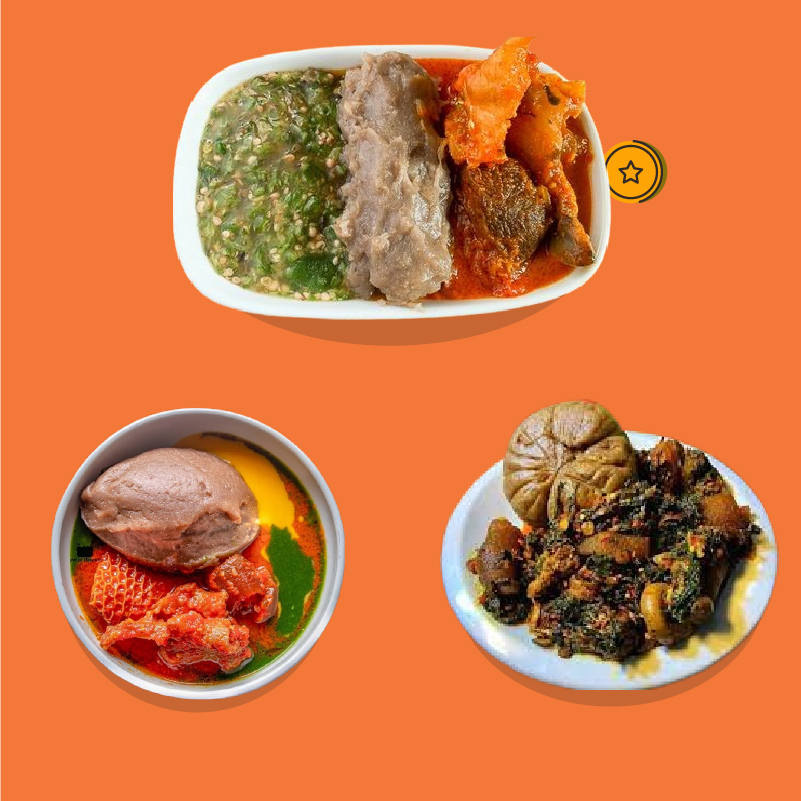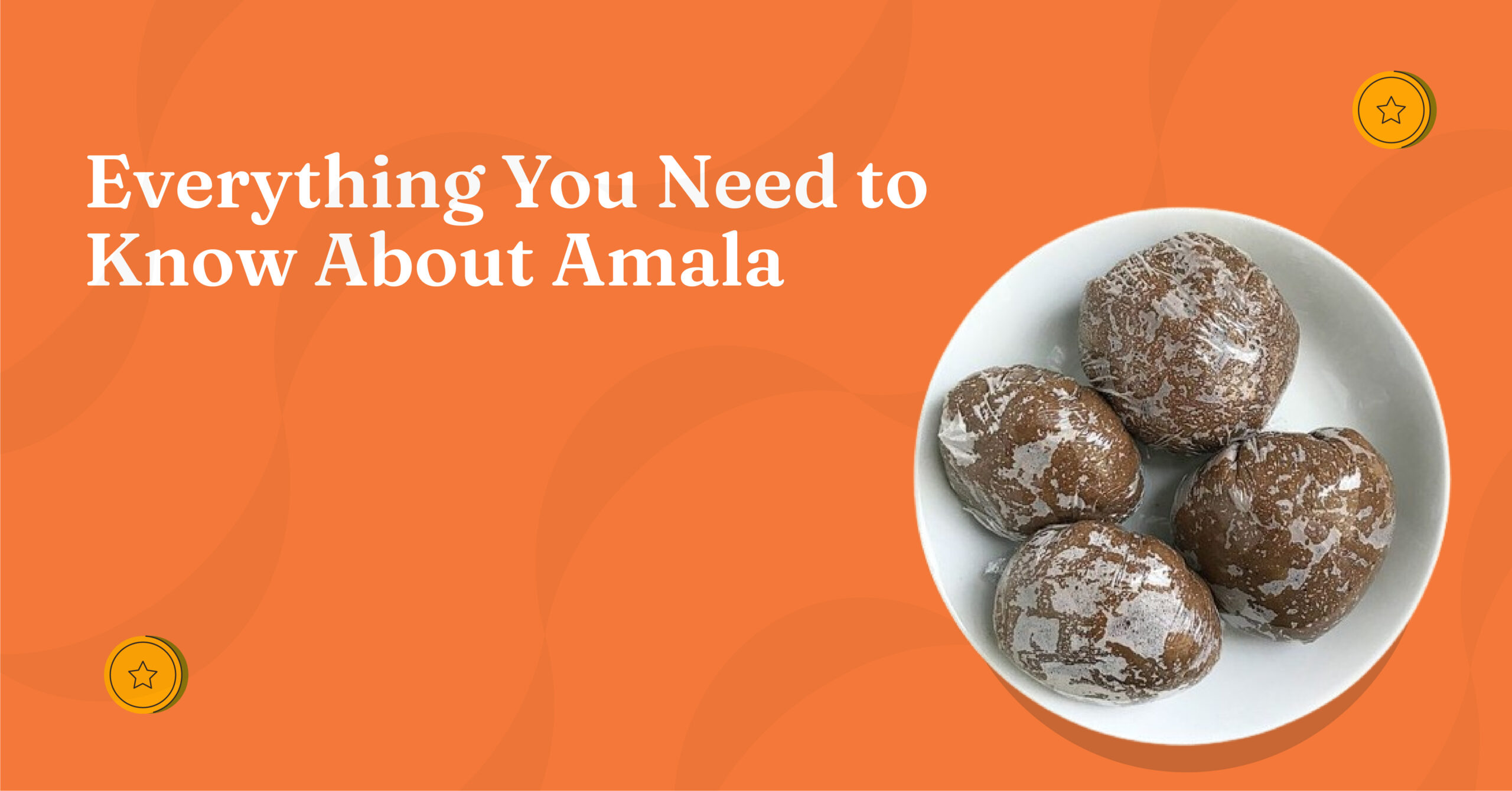As a Nigerian, Amala is more than just a meal; for many of us, it brings back memories of family gatherings, parties, and even quick stops at our favourite bukas. Whether it’s served at a wedding, a Sunday afternoon family meal, or during festive celebrations, Amala holds a special place on our tables. But what exactly is amala, and what makes it so special?
In this blog post, we will explore Amala, its variants, and health benefits and answer some of the most common questions people have about this iconic dish.
What is Amala?
Let’s start with the basics. Amala is a type of Nigerian swallow food. “Swallow” in Nigerian cuisine simply means soft, starchy food that you can easily swallow without chewing much. Other examples include fufu, eba and tuwo. Amala, like other swallows, is usually eaten with different soups.

What is Amala made of?
So, what is Amala made from? Well, there are three main types of Amala:
Yam-based Amala (àmàlà isu)
This is the most popular Amala. It’s crafted from a specific yam species called Dioscorea cayenensis, known locally as Ikoro. This yam is chosen for its high starch content, which gives the amala its characteristic texture. The yam is dried and ground into flour, which when mixed with hot water, creates a smooth, slightly sticky paste with a dark brown colour. This type of amala is particularly common in the yam-growing regions of West Africa.
Cassava-based Amala (àmàlà láfún)
This version of Amala uses cassava flour, also known as lafun in Nigeria or konkonte in Ghana. The cassava is processed into flour, which results in an amala that’s lighter in colour compared to the yam-based version. It has a unique taste and texture that many enjoy as an alternative to the yam-based amala.
Plantain-based Amala (àmàlà ogede)
Also known as elubo ogede, this type of amala is made from unripe plantains. The plantains are peeled, dried, and ground into flour before being cooked into a paste. It has a lighter colour than the yam-based amala and a subtle, slightly sweet taste. Interestingly, due to its lower carbohydrate content, plantain-based amala is often recommended for people managing diabetes.
What does Amala taste like?
Amala has a unique, satisfying texture that varies depending on the base ingredient. Yam-based Amala tends to have a rich, earthy flavour and a slightly sticky texture. Cassava-based Amala has a milder taste and a smoother consistency, while plantain-based Amala is subtly sweet with a softer texture. Each variant can enhance the taste of accompanying soups, making Amala a versatile dish in Nigerian cuisine.
What are the health benefits of Amala?
Now, you might be wondering, “Is Amala good for me?” The answer is yes. Amala has some great health benefits. Let’s break them down:
1. Amala provides a steady source of energy
Amala, especially the yam-based variety, is rich in complex carbohydrates, making it an excellent energy source. These carbs provide the fuel needed for daily activities and bodily functions. Unlike simple sugars, the energy from amala is released slowly, keeping you active and energised throughout the day.
2. Amala supports digestive health
Amala is a good source of dietary fibre, especially when it’s made from plantain or yam flour. This fibre aids digestion by promoting regular bowel movements and preventing constipation. Additionally, the fibre content helps maintain gut health and supports the secretion of digestive juices, making it easier for your body to process food.
3. Amala is rich in vitamins and minerals
Amala offers essential vitamins like vitamin C, which boosts your immune system, and minerals such as potassium and magnesium, which support heart health and muscle function. Plantain amala, in particular, provides more potassium, which helps regulate blood pressure and promotes overall cardiovascular health.
4. Amala is safe for diabetics
Amala is highly recommended for people with diabetes because of its low glycemic index. It digests slowly, preventing sudden spikes in blood sugar levels. This makes it a safer carbohydrate option for diabetics, allowing better glucose control. Plantain amala, with its lower carbohydrate content, is especially beneficial.
5. Amala is a gluten-free meal option
For those with gluten sensitivities or celiac disease, amala is a naturally gluten-free dish when made from yam or plantain flour. This makes it a great alternative for people who need to avoid gluten while still enjoying traditional Nigerian meals.
6. Amala has anti-inflammatory benefits
Amala, particularly from yam flour, contains anti-inflammatory properties that benefit the digestive system. Its anti-inflammatory properties may help soothe digestive discomforts, making amala gentle on the stomach.
Remember, the health benefits can vary depending on which type of amala you’re eating. But in general, amala can be part of a healthy diet when eaten in moderation.
How to make Amala flour at home
Making amala flour at home is easy if you follow these simple steps. Here’s a guide for making yam amala flour:
Choose your base: Decide if you want to use yam, cassava, or plantain.
Prepare: Peel and slice your chosen ingredient.
Dry: Slice the yam, cassava, or plantains into thin pieces and sun-dry them thoroughly. This process can take several days, depending on the weather.
Grind: Once fully dry, grind the pieces into fine flour.
Store: Keep your homemade flour in an airtight container.
If this sounds like too much work, don’t worry. You can always buy amala flour from local markets or online stores. Just look for good quality brands that use organic ingredients.
FAQs About Amala
Let’s answer some common questions about Amala:
1. What is Amala made from?
Amala can be made from yam, cassava, or plantain flour.
2. How to make Amala flour?
You can make amala flour by drying and grinding yam, cassava, or plantains.
3. What are the health benefits of Amala?
Amala provides energy, aids digestion, and can be part of a healthy diet when eaten in moderation.
4. Is Amala good for weight loss?
If you’re wondering whether Amala can fit into a weight loss plan, the answer can be yes, particularly when choosing plantain-based Amala. Its lower calorie content and high fibre make it a good option for those watching their weight. Pair it with healthy soups and lean proteins for a balanced meal.
5. Is Amala good for diabetes?
Good news for people with diabetes. Plantain-based amala has a low glycemic index. This means it doesn’t cause your blood sugar to spike quickly.
Now you know all about amala – what it is, its health benefits, how to make it, and more. Whether you’re a long-time amala lover or just getting started, we hope this information helps you enjoy this tasty Nigerian staple even more.
At Clafiya, we are committed to supporting your health and wellness journey. Visit our Health and Wellness Hub to access discounts of up to 30% from professional dietitians, diet clinics, and healthy food stores.
Whether you’re looking for personalised nutrition advice or support in making healthier food choices, we’re here to assist you every step of the way.
If you enjoyed reading this article, share it on social media with the buttons below👇🏽





